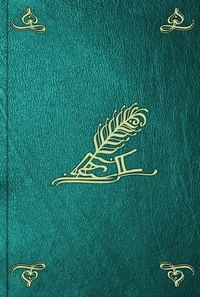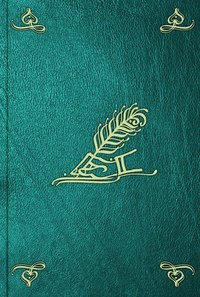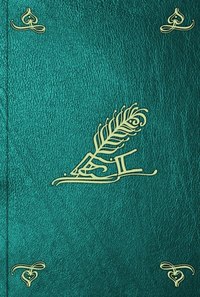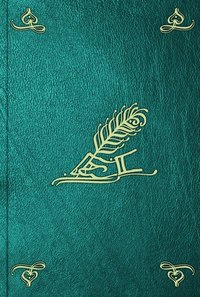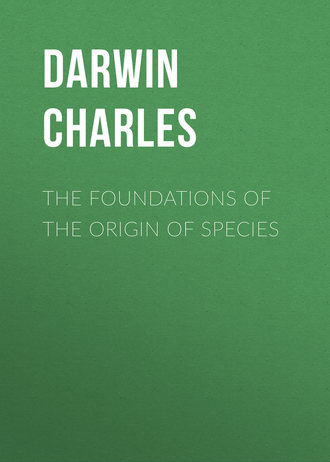 полная версия
полная версияThe Foundations of the Origin of Species
Let us now suppose a Being224 with penetration sufficient to perceive differences in the outer and innermost organization quite imperceptible to man, and with forethought extending over future centuries to watch with unerring care and select for any object the offspring of an organism produced under the foregoing circumstances; I can see no conceivable reason why he could not form a new race (or several were he to separate the stock of the original organism and work on several islands) adapted to new ends. As we assume his discrimination, and his forethought, and his steadiness of object, to be incomparably greater that those qualities in man, so we may suppose the beauty and complications of the adaptations of the new races and their differences from the original stock to be greater than in the domestic races produced by man’s agency: the ground-work of his labours we may aid by supposing that the external conditions of the volcanic island, from its continued emergence and the occasional introduction of new immigrants, vary; and thus to act on the reproductive system of the organism, on which he is at work, and so keep its organization somewhat plastic. With time enough, such a Being might rationally (without some unknown law opposed him) aim at almost any result.
For instance, let this imaginary Being wish, from seeing a plant growing on the decaying matter in a forest and choked by other plants, to give it power of growing on the rotten stems of trees, he would commence selecting every seedling whose berries were in the smallest degree more attractive to tree-frequenting birds, so as to cause a proper dissemination of the seeds, and at the same time he would select those plants which had in the slightest degree more and more power of drawing nutriment from rotten wood; and he would destroy all other seedlings with less of this power. He might thus, in the course of century after century, hope to make the plant by degrees grow on rotten wood, even high up on trees, wherever birds dropped the non-digested seeds. He might then, if the organization of the plant was plastic, attempt by continued selection of chance seedlings to make it grow on less and less rotten wood, till it would grow on sound wood225. Supposing again, during these changes the plant failed to seed quite freely from non-impregnation, he might begin selecting seedlings with a little sweeter «or» differently tasted honey or pollen, to tempt insects to visit the flowers regularly: having effected this, he might wish, if it profited the plant, to render abortive the stamens and pistils in different flowers, which he could do by continued selection. By such steps he might aim at making a plant as wonderfully related to other organic beings as is the mistletoe, whose existence absolutely depends on certain insects for impregnation, certain birds for transportal, and certain trees for growth. Furthermore, if the insect which had been induced regularly to visit this hypothetical plant profited much by it, our same Being might wish by selection to modify by gradual selection the insect’s structure, so as to facilitate its obtaining the honey or pollen: in this manner he might adapt the insect (always presupposing its organization to be in some degree plastic) to the flower, and the impregnation of the flower to the insect; as is the case with many bees and many plants.
Seeing what blind capricious man has actually effected by selection during the few last years, and what in a ruder state he has probably effected without any systematic plan during the last few thousand years, he will be a bold person who will positively put limits to what the supposed Being could effect during whole geological periods. In accordance with the plan by which this universe seems governed by the Creator, let us consider whether there exists any secondary means in the economy of nature by which the process of selection could go on adapting, nicely and wonderfully, organisms, if in ever so small a degree plastic, to diverse ends. I believe such secondary means do exist226.
Natural means of Selection 227
De Candolle, in an eloquent passage, has declared that all nature is at war, one organism with another, or with external nature. Seeing the contented face of nature, this may at first be well doubted; but reflection will inevitably prove it is too true. The war, however, is not constant, but only recurrent in a slight degree at short periods and more severely at occasional more distant periods; and hence its effects are easily overlooked. It is the doctrine of Malthus applied in most cases with ten-fold force. As in every climate there are seasons for each of its inhabitants of greater and less abundance, so all annually breed; and the moral restraint, which in some small degree checks the increase of mankind, is entirely lost. Even slow-breeding mankind has doubled in 25 years228, and if he could increase his food with greater ease, he would double in less time. But for animals, without artificial means, on an average the amount of food for each species must be constant; whereas the increase of all organisms tends to be geometrical, and in a vast majority of cases at an enormous ratio. Suppose in a certain spot there are eight pairs of [robins] birds, and that only four pairs of them annually (including double hatches) rear only four young; and that these go on rearing their young at the same rate: then at the end of seven years (a short life, excluding violent deaths, for any birds) there will be 2048 robins, instead of the original sixteen; as this increase is quite impossible, so we must conclude either that robins do not rear nearly half their young or that the average life of a robin when reared is from accident not nearly seven years. Both checks probably concur. The same kind of calculation applied to all vegetables and animals produces results either more or less striking, but in scarcely a single instance less striking than in man229.
Many practical illustrations of this rapid tendency to increase are on record, namely during peculiar seasons, in the extraordinary increase of certain animals, for instance during the years 1826 to 1828, in La Plata, when from drought, some millions of cattle perished, the whole country swarmed with innumerable mice: now I think it cannot be doubted that during the breeding season all the mice (with the exception of a few males or females in excess) ordinarily pair; and therefore that this astounding increase during three years must be attributed to a greater than usual number surviving the first year, and then breeding, and so on, till the third year, when their numbers were brought down to their usual limits on the return of wet weather. Where man has introduced plants and animals into a new country favourable to them, there are many accounts in how surprisingly few years the whole country has become stocked with them. This increase would necessarily stop as soon as the country was fully stocked; and yet we have every reason to believe from what is known of wild animals that all would pair in the spring. In the majority of cases it is most difficult to imagine where the check falls, generally no doubt on the seeds, eggs, and young; but when we remember how impossible even in mankind (so much better known than any other animal) it is to infer from repeated casual observations what the average of life is, or to discover how different the percentage of deaths to the births in different countries, we ought to feel no legitimate surprise at not seeing where the check falls in animals and plants. It should always be remembered that in most cases the checks are yearly recurrent in a small regular degree, and in an extreme degree during occasionally unusually cold, hot, dry, or wet years, according to the constitution of the being in question. Lighten any check in the smallest degree, and the geometrical power of increase in every organism will instantly increase the average numbers of the favoured species. Nature may be compared to a surface, on which rest ten thousand sharp wedges touching each other and driven inwards by incessant blows230. Fully to realise these views much reflection is requisite; Malthus on man should be studied; and all such cases as those of the mice in La Plata, of the cattle and horses when first turned out in S. America, of the robins by our calculation, &c., should be well considered: reflect on the enormous multiplying power inherent and annually in action in all animals; reflect on the countless seeds scattered by a hundred ingenious contrivances, year after year, over the whole face of the land; and yet we have every reason to suppose that the average percentage of every one of the inhabitants of a country will ordinarily remain constant. Finally, let it be borne in mind that this average number of individuals (the external conditions remaining the same) in each country is kept up by recurrent struggles against other species or against external nature (as on the borders of the arctic regions231, where the cold checks life); and that ordinarily each individual of each species holds its place, either by its own struggle and capacity of acquiring nourishment in some period (from the egg upwards) of its life, or by the struggle of its parents (in short lived organisms, when the main check occurs at long intervals) against and compared with other individuals of the same or different species.
But let the external conditions of a country change; if in a small degree, the relative proportions of the inhabitants will in most cases simply be slightly changed; but let the number of inhabitants be small, as in an island232, and free access to it from other countries be circumscribed; and let the change of condition continue progressing (forming new stations); in such case the original inhabitants must cease to be so perfectly adapted to the changed conditions as they originally were. It has been shown that probably such changes of external conditions would, from acting on the reproductive system, cause the organization of the beings most affected to become, as under domestication, plastic. Now can it be doubted from the struggle each individual (or its parents) has to obtain subsistence that any minute variation in structure, habits, or instincts, adapting that individual better to the new conditions, would tell upon its vigour and health? In the struggle it would have a better chance of surviving, and those of its offspring which inherited the variation, let it be ever so slight, would have a better chance to survive. Yearly more are bred than can survive; the smallest grain in the balance, in the long run, must tell on which death shall fall, and which shall survive233. Let this work of selection, on the one hand, and death on the other, go on for a thousand generations; who would pretend to affirm that it would produce no effect, when we remember what in a few years Bakewell effected in cattle and Western in sheep, by this identical principle of selection.
To give an imaginary example, from changes in progress on an island, let the organization234 of a canine animal become slightly plastic, which animal preyed chiefly on rabbits, but sometimes on hares; let these same changes cause the number of rabbits very slowly to decrease and the number of hares to increase; the effect of this would be that the fox or dog would be driven to try to catch more hares, and his numbers would tend to decrease; his organization, however, being slightly plastic, those individuals with the lightest forms, longest limbs, and best eye-sight (though perhaps with less cunning or scent) would be slightly favoured, let the difference be ever so small, and would tend to live longer and to survive during that time of the year when food was shortest; they would also rear more young, which young would tend to inherit these slight peculiarities. The less fleet ones would be rigidly destroyed. I can see no more reason to doubt but that these causes in a thousand generations would produce a marked effect, and adapt the form of the fox to catching hares instead of rabbits, than that greyhounds can be improved by selection and careful breeding. So would it be with plants under similar circumstances; if the number of individuals of a species with plumed seeds could be increased by greater powers of dissemination within its own area (that is if the check to increase fell chiefly on the seeds), those seeds which were provided with ever so little more down, or with a plume placed so as to be slightly more acted on by the winds, would in the long run tend to be most disseminated; and hence a greater number of seeds thus formed would germinate, and would tend to produce plants inheriting this slightly better adapted down.
Besides this natural means of selection, by which those individuals are preserved, whether in their egg or seed or in their mature state, which are best adapted to the place they fill in nature, there is a second agency at work in most bisexual animals tending to produce the same effect, namely the struggle of the males for the females. These struggles are generally decided by the law of battle; but in the case of birds, apparently, by the charms of their song235, by their beauty or their power of courtship, as in the dancing rock-thrush of Guiana. Even in the animals which pair there seems to be an excess of males which would aid in causing a struggle: in the polygamous animals236, however, as in deer, oxen, poultry, we might expect there would be severest struggle: is it not in the polygamous animals that the males are best formed for mutual war? The most vigorous males, implying perfect adaptation, must generally gain the victory in their several contests. This kind of selection, however, is less rigorous than the other; it does not require the death of the less successful, but gives to them fewer descendants. This struggle falls, moreover, at a time of year when food is generally abundant, and perhaps the effect chiefly produced would be the alteration of sexual characters, and the selection of individual forms, no way related to their power of obtaining food, or of defending themselves from their natural enemies, but of fighting one with another. This natural struggle amongst the males may be compared in effect, but in a less degree, to that produced by those agriculturalists who pay less attention to the careful selection of all the young animals which they breed and more to the occasional use of a choice male237.
Differences between “Races” and “Species”: – first, in their trueness or variability
Races238 produced by these natural means of selection239 we may expect would differ in some respects from those produced by man. Man selects chiefly by the eye, and is not able to perceive the course of every vessel and nerve, or the form of the bones, or whether the internal structure corresponds to the outside shape. He240 is unable to select shades of constitutional differences, and by the protection he affords and his endeavours to keep his property alive, in whatever country he lives, he checks, as much as lies in his power, the selecting action of nature, which will, however, go on to a lesser degree with all living things, even if their length of life is not determined by their own powers of endurance. He has bad judgment, is capricious, he does not, or his successors do not, wish to select for the same exact end for hundreds of generations. He cannot always suit the selected form to the properest conditions; nor does he keep those conditions uniform: he selects that which is useful to him, not that best adapted to those conditions in which each variety is placed by him: he selects a small dog, but feeds it highly; he selects a long-backed dog, but does not exercise it in any peculiar manner, at least not during every generation. He seldom allows the most vigorous males to struggle for themselves and propagate, but picks out such as he possesses, or such as he prefers, and not necessarily those best adapted to the existing conditions. Every agriculturalist and breeder knows how difficult it is to prevent an occasional cross with another breed. He often grudges to destroy an individual which departs considerably from the required type. He often begins his selection by a form or sport considerably departing from the parent form. Very differently does the natural law of selection act; the varieties selected differ only slightly from the parent forms241; the conditions are constant for long periods and change slowly; rarely can there be a cross; the selection is rigid and unfailing, and continued through many generations; a selection can never be made without the form be better adapted to the conditions than the parent form; the selecting power goes on without caprice, and steadily for thousands of years adapting the form to these conditions. The selecting power is not deceived by external appearances, it tries the being during its whole life; and if less well «?» adapted than its congeners, without fail it is destroyed; every part of its structure is thus scrutinised and proved good towards the place in nature which it occupies.
We have every reason to believe that in proportion to the number of generations that a domestic race is kept free from crosses, and to the care employed in continued steady selection with one end in view, and to the care in not placing the variety in conditions unsuited to it; in such proportion does the new race become “true” or subject to little variation242. How incomparably “truer” then would a race produced by the above rigid, steady, natural means of selection, excellently trained and perfectly adapted to its conditions, free from stains of blood or crosses, and continued during thousands of years, be compared with one produced by the feeble, capricious, misdirected and ill-adapted selection of man. Those races of domestic animals produced by savages, partly by the inevitable conditions of their life, and partly unintentionally by their greater care of the individuals most valuable to them, would probably approach closest to the character of a species; and I believe this is the case. Now the characteristic mark of a species, next, if not equal in importance to its sterility when crossed with another species, and indeed almost the only other character (without we beg the question and affirm the essence of a species, is its not having descended from a parent common to any other form), is the similarity of the individuals composing the species, or in the language of agriculturalists their “trueness.”
Difference between “Races” and “Species” in fertility when crossed
The sterility of species, or of their offspring, when crossed has, however, received more attention than the uniformity in character of the individuals composing the species. It is exceedingly natural that such sterility243 should have been long thought the certain characteristic of species. For it is obvious that if the allied different forms which we meet with in the same country could cross together, instead of finding a number of distinct species, we should have a confused and blending series. The fact however of a perfect gradation in the degree of sterility between species, and the circumstance of some species most closely allied (for instance many species of crocus and European heaths) refusing to breed together, whereas other species, widely different, and even belonging to distinct genera, as the fowl and the peacock, pheasant and grouse244, Azalea and Rhododendron, Thuja and Juniperus, breeding together ought to have caused a doubt whether the sterility did not depend on other causes, distinct from a law, coincident with their creation. I may here remark that the fact whether one species will or will not breed with another is far less important than the sterility of the offspring when produced; for even some domestic races differ so greatly in size (as the great stag-greyhound and lap-dog, or cart-horse and Burmese ponies) that union is nearly impossible; and what is less generally known is, that in plants Kölreuter has shown by hundreds of experiments that the pollen of one species will fecundate the germen of another species, whereas the pollen of this latter will never act on the germen of the former; so that the simple fact of mutual impregnation certainly has no relation whatever to the distinctness in creation of the two forms. When two species are attempted to be crossed which are so distantly allied that offspring are never produced, it has been observed in some cases that the pollen commences its proper action by exserting its tube, and the germen commences swelling, though soon afterwards it decays. In the next stage in the series, hybrid offspring are produced though only rarely and few in number, and these are absolutely sterile: then we have hybrid offspring more numerous, and occasionally, though very rarely, breeding with either parent, as is the case with the common mule. Again, other hybrids, though infertile inter se, will breed quite freely with either parent, or with a third species, and will yield offspring generally infertile, but sometimes fertile; and these latter again will breed with either parent, or with a third or fourth species: thus Kölreuter blended together many forms. Lastly it is now admitted by those botanists who have longest contended against the admission, that in certain families the hybrid offspring of many of the species are sometimes perfectly fertile in the first generation when bred together: indeed in some few cases Mr Herbert245 found that the hybrids were decidedly more fertile than either of their pure parents. There is no way to escape from the admission that the hybrids from some species of plants are fertile, except by declaring that no form shall be considered as a species, if it produces with another species fertile offspring: but this is begging the question246. It has often been stated that different species of animals have a sexual repugnance towards each other; I can find no evidence of this; it appears as if they merely did not excite each others passions. I do not believe that in this respect there is any essential distinction between animals and plants; and in the latter there cannot be a feeling of repugnance.
Causes of Sterility in Hybrids
The difference in nature between species which causes the greater or lesser degree of sterility in their offspring appears, according to Herbert and Kölreuter, to be connected much less with external form, size, or structure, than with constitutional peculiarities; by which is meant their adaptation to different climates, food and situation, &c.: these peculiarities of constitution probably affect the entire frame, and no one part in particular247.
From the foregoing facts I think we must admit that there exists a perfect gradation in fertility between species which when crossed are quite fertile (as in Rhododendron, Calceolaria, &c.), and indeed in an extraordinary degree fertile (as in Crinum), and those species which never produce offspring, but which by certain effects (as the exsertion of the pollen-tube) evince their alliance. Hence, I conceive, we must give up sterility, although undoubtedly in a lesser or greater degree of very frequent occurrence, as an unfailing mark by which species can be distinguished from races, i. e. from those forms which have descended from a common stock.
Infertility from causes distinct from hybridisation
Let us see whether there are any analogous facts which will throw any light on this subject, and will tend to explain why the offspring of certain species, when crossed, should be sterile, and not others, without requiring a distinct law connected with their creation to that effect. Great numbers, probably a large majority of animals when caught by man and removed from their natural conditions, although taken very young, rendered quite tame, living to a good old age, and apparently quite healthy, seem incapable under these circumstances of breeding248. I do not refer to animals kept in menageries, such as at the Zoological Gardens, many of which, however, appear healthy and live long and unite but do not produce; but to animals caught and left partly at liberty in their native country. Rengger249 enumerates several caught young and rendered tame, which he kept in Paraguay, and which would not breed: the hunting leopard or cheetah and elephant offer other instances; as do bears in Europe, and the 25 species of hawks, belonging to different genera, thousands of which have been kept for hawking and have lived for long periods in perfect vigour. When the expense and trouble of procuring a succession of young animals in a wild state be borne in mind, one may feel sure that no trouble has been spared in endeavours to make them breed. So clearly marked is this difference in different kinds of animals, when captured by man, that St Hilaire makes two great classes of animals useful to man: – the tame, which will not breed, and the domestic which will breed in domestication. From certain singular facts we might have supposed that the non-breeding of animals was owing to some perversion of instinct. But we meet with exactly the same class of facts in plants: I do not refer to the large number of cases where the climate does not permit the seed or fruit to ripen, but where the flowers do not “set,” owing to some imperfection of the ovule or pollen. The latter, which alone can be distinctly examined, is often manifestly imperfect, as any one with a microscope can observe by comparing the pollen of the Persian and Chinese lilacs250 with the common lilac; the two former species (I may add) are equally sterile in Italy as in this country. Many of the American bog plants here produce little or no pollen, whilst the Indian species of the same genera freely produce it. Lindley observes that sterility is the bane of the horticulturist251: Linnæus has remarked on the sterility of nearly all alpine flowers when cultivated in a lowland district252. Perhaps the immense class of double flowers chiefly owe their structure to an excess of food acting on parts rendered slightly sterile and less capable of performing their true function, and therefore liable to be rendered monstrous, which monstrosity, like any other disease, is inherited and rendered common. So far from domestication being in itself unfavourable to fertility, it is well known that when an organism is once capable of submission to such conditions «its» fertility is increased253 beyond the natural limit. According to agriculturists, slight changes of conditions, that is of food or habitation, and likewise crosses with races slightly different, increase the vigour and probably the fertility of their offspring. It would appear also that even a great change of condition, for instance, transportal from temperate countries to India, in many cases does not in the least affect fertility, although it does health and length of life and the period of maturity. When sterility is induced by domestication it is of the same kind, and varies in degree, exactly as with hybrids: for be it remembered that the most sterile hybrid is no way monstrous; its organs are perfect, but they do not act, and minute microscopical investigations show that they are in the same state as those of pure species in the intervals of the breeding season. The defective pollen in the cases above alluded to precisely resembles that of hybrids. The occasional breeding of hybrids, as of the common mule, may be aptly compared to the most rare but occasional reproduction of elephants in captivity. The cause of many exotic Geraniums producing (although in vigorous health) imperfect pollen seems to be connected with the period when water is given them254; but in the far greater majority of cases we cannot form any conjecture on what exact cause the sterility of organisms taken from their natural conditions depends. Why, for instance, the cheetah will not breed whilst the common cat and ferret (the latter generally kept shut up in a small box) do, – why the elephant will not whilst the pig will abundantly – why the partridge and grouse in their own country will not, whilst several species of pheasants, the guinea-fowl from the deserts of Africa and the peacock from the jungles of India, will. We must, however, feel convinced that it depends on some constitutional peculiarities in these beings not suited to their new condition; though not necessarily causing an ill state of health. Ought we then to wonder much that those hybrids which have been produced by the crossing of species with different constitutional tendencies (which tendencies we know to be eminently inheritable) should be sterile: it does not seem improbable that the cross from an alpine and lowland plant should have its constitutional powers deranged, in nearly the same manner as when the parent alpine plant is brought into a lowland district. Analogy, however, is a deceitful guide, and it would be rash to affirm, although it may appear probable, that the sterility of hybrids is due to the constitutional peculiarities of one parent being disturbed by being blended with those of the other parent in exactly the same manner as it is caused in some organic beings when placed by man out of their natural conditions255. Although this would be rash, it would, I think, be still rasher, seeing that sterility is no more incidental to all cross-bred productions than it is to all organic beings when captured by man, to assert that the sterility of certain hybrids proved a distinct creation of their parents.


